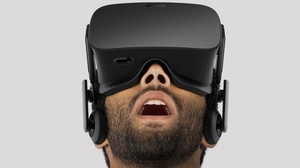
Every year Michael Parker, ex-pat Kiwi equity strategist and author of The Pine Tree Paradox, issues a report highlighting a chart of the year.
This year the Hong Kong-based Parker, who to give him his full title is managing director, strategist and deputy director of research at Bernstein, and his colleagues, have chosen this one.
In Bernstein's report entitled 'Let The Brainwashing Begin... Chart of the Year (Not Ours),' Parker explains why. It's all about virtual reality, learning and boosting workers' productivity.
He notes last year's chart of the year, which I covered here, was his colleague Alberto Moel's analysis of global robot sales. This features China at No.1 and gaining share. Writing about that chart Parker's observation was that automation was making manufacturing activity cheaper and less labour-intensive. Income inequality in developing markets will continue to rise as work now means competing against other unskilled service workers rather than banding together and unionising, he opines.
But the bigger risk, which Parker says has become more apparent this year, is that Adam Smith's 18th century observation about specialisation is now outdated.
"Low cost markets in Asia will not inherit low skill manufacturing work. As wages rise, Chinese manufacturing will ditch its workers, but retain – and automate – the work. The tempting response in developed market is protectionism. Trade barriers may respect borders. But robots do not. The only response in developing markets - ex-China - is continuing misery and rising income inequality," says Parker.
"Our Chart of the Year for 2017 belongs to our Asia emerging technologies analyst David Dai, and presents a far more optimistic view of economic development and the future."
This highlights work by US educational theorist Edgar Dale and the Cone of Knowledge, which was first published as long ago as 1946.
"Dale calculated that when you read, you retain 10% of the information. You retain 20% of the information that you hear. But you retain 90% of what you experience. The direct consequence of Dale's work was a revolution in K-12 education," Parker explains. "Instead of trying to explain an abstraction like a fraction to a roomful of eight year-olds, why not let them play with coloured Cuisenaire rods, developed by Belgian school teacher Emile-Georges Cuisenaire and popularised though his 1952 text "Les nombres en couleurs"?
Parker goes on to acknowledge that whilst learning by doing is an important insight, it doesn't qualify as new in 2017.
"It all becomes far more significant when you add in advances in computing power, artificial intelligence and machine learning. With a virtual reality headset, all the learning experiences of a primary and secondary student or even university student are transformed. If you are - courtesy of a virtual reality headset - sitting under the apple tree with Sir Isaac Newton, flying a kite with Benjamin Franklin or even in the bath with Archimedes, the laws of gravity, the properties of electricity and the principles of displacement are far easier to discern and retain," says Parker.
Additionally, he points out, the implications of virtual reality aren't limited to the classroom. Every knowledge worker in the world in 2017 is in a state of constant learning. The most dynamic economies in the world, such as those in Northern California, South Korea, Taiwan, plus China's Shenzhen and Shanghai, are dominated by companies that rely on teams of smart, innovative, hard-working staff who are constantly learning and improving.
"What if that entire cohort - which is to say, every worker in every tech company, pharma start-up, engineering firm, bank, law firm, consultancy and every other organisation in the world - could learn 5x faster? If productivity were to increase 5x for every knowledge worker in the world and you make the conservative assumption that the output of knowledge workers accounts for 25% of the US$80 trillion global economy, then global output doubles ([20 trillion x 5 + (80-20 trillion])," says Parker.
"For anyone worried about what is going to become of all the world's displaced factory workers, typists, taxi drivers and pirate DVD resellers… relax. We think we have found the perfect Thanksgiving surprise: an extra $80 trillion hidden under the sofa cushion, all thanks to virtual reality."
Parker does, however, make the point that as they're currently designed virtual reality headsets look ridiculous. However, he says that if virtual reality devices getting smaller, sleeker and more powerful is the only constraint to mass adoption of virtual reality, and a doubling of the global economy, "then buckle up. And let the brainwashing begin."
Below: The size of the global economy and the key contributors.
This article was first published in our email for paying subscribers early on Thursday morning. See here for more details and how to subscribe.


We welcome your comments below. If you are not already registered, please register to comment.
Remember we welcome robust, respectful and insightful debate. We don't welcome abusive or defamatory comments and will de-register those repeatedly making such comments. Our current comment policy is here.